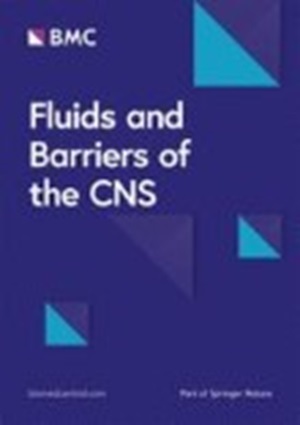SARS-CoV-2 可能通过调节 Wnt 信号通路导致人 iPSC 衍生脑微血管内皮细胞功能障碍
IF 5.9
1区 医学
Q1 NEUROSCIENCES
引用次数: 0
摘要
严重急性呼吸系统综合征冠状病毒 2(SARS-CoV-2)会引起 2019 年冠状病毒病(COVID-19),并伴有各种神经系统症状,包括恶心、头晕、头痛、脑炎和癫痫发作。SARS-CoV-2 被认为是通过与血脑屏障(BBB)相互作用来影响中枢神经系统(CNS)的,而血脑屏障是由封闭脑微血管内皮细胞(BMECs)之间旁细胞间隙的紧密连接所定义的。虽然已有 SARS-CoV-2 感染 BMEC 的报道,但其详细机制尚未完全阐明。利用 SARS-CoV-2 原始菌株,通过检测细胞内 RNA 拷贝数和病毒颗粒定位,确认了 BMECs 的感染。通过测量跨内皮电阻(TEER)和促炎症基因的表达水平来评估 BMEC 的功能,TEER 可评估紧密连接动态的完整性。通过全面的 RNA-seq 分析研究了 BMEC 信号通路。我们观察到,iPSC 衍生的脑微血管内皮样细胞(iPSC-BMELCs)感染了 SARS-CoV-2。SARS-CoV-2 感染导致 TEER 下降。此外,SARS-CoV-2 感染还降低了紧密连接标记物 CLDN3 和 CLDN11 的表达水平。SARS-CoV-2 感染还增加了促炎症基因的表达水平,众所周知,这些基因在 COVID-19 患者中会升高。此外,RNA-seq分析显示,SARS-CoV-2对iPSC-BMELCs中的典型Wnt信号通路进行了失调。CHIR99021 对 Wnt 信号的调节部分抑制了感染和随后的炎症反应。这些发现表明,SARS-CoV-2感染会通过Wnt信号传导导致BBB功能障碍。因此,iPSC-BMELCs 是阐明 COVID-19 神经病理学和药物开发的有用体外模型。本文章由计算机程序翻译,如有差异,请以英文原文为准。
SARS-CoV-2 causes dysfunction in human iPSC-derived brain microvascular endothelial cells potentially by modulating the Wnt signaling pathway
Severe acute respiratory syndrome coronavirus 2 (SARS-CoV-2) causes coronavirus disease 2019 (COVID-19), which is associated with various neurological symptoms, including nausea, dizziness, headache, encephalitis, and epileptic seizures. SARS-CoV-2 is considered to affect the central nervous system (CNS) by interacting with the blood–brain barrier (BBB), which is defined by tight junctions that seal paracellular gaps between brain microvascular endothelial cells (BMECs). Although SARS-CoV-2 infection of BMECs has been reported, the detailed mechanism has not been fully elucidated. Using the original strain of SARS-CoV-2, the infection in BMECs was confirmed by a detection of intracellular RNA copy number and localization of viral particles. BMEC functions were evaluated by measuring transendothelial electrical resistance (TEER), which evaluates the integrity of tight junction dynamics, and expression levels of proinflammatory genes. BMEC signaling pathway was examined by comprehensive RNA-seq analysis. We observed that iPSC derived brain microvascular endothelial like cells (iPSC-BMELCs) were infected with SARS-CoV-2. SARS-CoV-2 infection resulted in decreased TEER. In addition, SARS-CoV-2 infection decreased expression levels of tight junction markers CLDN3 and CLDN11. SARS-CoV-2 infection also increased expression levels of proinflammatory genes, which are known to be elevated in patients with COVID-19. Furthermore, RNA-seq analysis revealed that SARS-CoV-2 dysregulated the canonical Wnt signaling pathway in iPSC-BMELCs. Modulation of the Wnt signaling by CHIR99021 partially inhibited the infection and the subsequent inflammatory responses. These findings suggest that SARS-CoV-2 infection causes BBB dysfunction via Wnt signaling. Thus, iPSC-BMELCs are a useful in vitro model for elucidating COVID-19 neuropathology and drug development.
求助全文
通过发布文献求助,成功后即可免费获取论文全文。
去求助
来源期刊

Fluids and Barriers of the CNS
Neuroscience-Developmental Neuroscience
CiteScore
10.70
自引率
8.20%
发文量
94
审稿时长
14 weeks
期刊介绍:
"Fluids and Barriers of the CNS" is a scholarly open access journal that specializes in the intricate world of the central nervous system's fluids and barriers, which are pivotal for the health and well-being of the human body. This journal is a peer-reviewed platform that welcomes research manuscripts exploring the full spectrum of CNS fluids and barriers, with a particular focus on their roles in both health and disease.
At the heart of this journal's interest is the cerebrospinal fluid (CSF), a vital fluid that circulates within the brain and spinal cord, playing a multifaceted role in the normal functioning of the brain and in various neurological conditions. The journal delves into the composition, circulation, and absorption of CSF, as well as its relationship with the parenchymal interstitial fluid and the neurovascular unit at the blood-brain barrier (BBB).
 求助内容:
求助内容: 应助结果提醒方式:
应助结果提醒方式:


